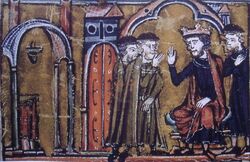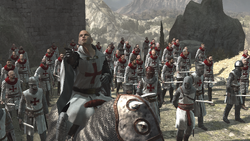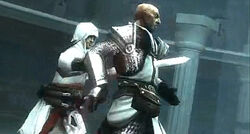The Levantine Rite of the Templar Order,[1] or simply the Knights Templar, were a group of like-minded individuals who swore fealty to the Templar ideals, and operated throughout Levant during the Crusades period of the 11th century to the 14th century. During the period of the Third Crusade, they fought alongside the Christian Army, consisting by Crusaders, Hospitaliers and Teutonics against the Saracen Army and Levantine Assassins.
History
- "Non nobis Domine, non nobis, sed Nomini Tuo da Gloriam"
"(Not to us God, not to us, but to Your Name Give Glory)" - ―The motto of the monastic Templar Order[src]
Crucifixion of Jesus
During the 1st century, the Templars discovered that one of the Pieces of Eden, the Shroud, was in the hands of Jesus Christ, who used it to perform restorative miracles. Wanting the Piece for their own purposes, the Templars crucified Jesus in order to gain it.[2] However, Jesus' disciples were able to recover the Shroud and attempted to harness its powers to resurrect him.[3]
Formation as a Knightly Order

Baldwin II ceding Al-Aqsa Mosque to Hugues de Payens
When Christian European lords tried to retake the Holy Land from its Muslim rulers during the Crusades, Bernard de Clairvaux decided the Templars needed the Church as an ally. In 1119, He sent nine of his trusted men, including Grand Master Hugues de Payens, to the Holy Land, searching for Solomon's Temple in Jerusalem. After arriving in Jerusalem, de Payens proposed to Baldwin II of Jerusalem that the Order be founded to protect pilgrims traveling to the Holy Land. Baldwin approved this, and ceded the Al-Aqsa Mosque to the Templars as a headquarters.[4]
Upon returning nine years later, de Payens, together with Bernard, created the Latin Rule, and reorganized the Templars into a public order of knights, whose apparent sole purpose was to protect pilgrims to the Holy Land. In the 1129 Council of Troyes, the order was officially recognized by the church.[4]
Just a few decades previously, their mortal adversaries, the Assassins had also reconstituted as a public organization and as they were primarily based in the Levant at the time, the two factions often clashed.
Quest for the Chalice
In 1190, the Templars led by Lord Basilisk were searching for a mysterious artifact known as the Chalice rumored to possess the power to unite the factions of the war and to be hidden in the Temple of Sand. To that end, they furiously pursued the three keys thought to be needed to enter the temple, as well as the map to its location. The Assassin Altaïr Ibn-La'Ahad thwarted their attempts at every turn, retrieving the keys and the map for his own use, but ultimately, they managed to launch an expedition to the Temple and break into its premises anyways even without these items.[5]
The Temple turned out empty, and they discovered that the Chalice was in fact a woman by the name of Adha, who they would soon after hold hostage in Jerusalem. In the meantime, they bribed Harash, the second most senior member of the Assassins, to serve as their spy. Though Altaïr's successfully rescued Adha, the Templars recaptured her in Tyre while the Assassin was dealing with Harash in Alep.[5]
Before they set sail with Adha, Altaïr confronted their forces at the Tyre harbor. The lone Assassin managed to fight his way through the army, killing even Basilisk himself in single combat, but the Templars escaped with Adha nonetheless. For many days and nights, the Templars hurried to their destination, all while the Assassin pursued them across the Mediterranean Sea close behind.[5] By the time he caught up, they had executed Adha, an outrage that would result in the death of every Templar responsible for her capture at the hands of the vengeful Assassin.[2]
Third Crusade
In 1189, the Templars became involved in the Third Crusade, fighting on the side of fellow Crusaders such as the Knights Hospitalier and Teutonic Knights. Under the leadership of Grand Master Gerard de Ridefort, a great force of them were involved in the Siege of Acre. Ridefort was personally executed by Saladin, Sultan of Egypt and Syria, when the Saracen army arrived in an attempt to lift the siege. His death would result in a year without an official Grand Master, with de facto leadership undertaken by Basilisk. After many months, the Templars became agitated by the stalemate and devised a scheme to poison every water source in the city in the hopes that it would kill off its entire population by the next morning, allowing them to seize Acre without a fight. The plot failed to come to fruition when Altaïr stopped the operation by infiltrating the Templar camp and assassinating its commander.[5] In spite of this setback, the Crusaders still managed to capture Acre after two years of siege,[6] leading to a temporary truce between the Crusaders and Saracens.
By 1191, the Templars had appointed Robert de Sablé as Ridefort's official successor. De Sablé began covertly recruiting men on both sides of the war. Among these were Garnier de Naplouse, William of Montferrat and Sibrand of the Crusaders, and Tamir, Talal, Abu'l Nuqoud, Majd Addin and Jubair al Hakim of the Saracens. Each of these men cooperated to obtain the Apple of Eden hidden with in the Ark of the Covenant at the Jerusalem Vault in Solomon's Temple, as well as to conspire to bring about their vision of a New World Order. While Tamir produced weapons for the Templars and Abu'l Nuqoud provided funds, Talal provided slaves for Garnier to experiment with in the hopes of developing drugs that could render people subservient to their will. Meanwhile, Jubair purged Damascus of books he found in conflict with Templar ideology, and Sibrand prepared his fleet for a blockade that would deter Europe from sending reinforcements once the Levant was under Templar control. William and Majd Addin served as regents for Acre and Damascus respectively, and the former's execution of three thousand Saracen prisoners-of-war would reignite the war with Saladin. Unknown to the Assassins, however, was that their leader Al Mualim had joined with the Templar cause, though only as a means to obtain the Apple for himself.[6]

Robert de Sable leading the Templars to Masyaf
When Robert de Sablé and a few of his men went to retrieve it from the temple, though, their progress was delayed by a small group of Assassins consisting of Altaïr Ibn-La'Ahad and the brothers Malik and Kadar Al-Sayf, who were sent by Al Mualim to retrieve the treasure. Though they routed Altaïr and killed Kadar, Malik managed to bring the artifact into Assassin possession even after losing one arm. This event prompted Robert to lead his men to an attack on the Assassins' fortress of Masyaf, but as soon as they arrived at the fortress gates, they were routed by a wave of falling tree logs.[6]
To ensure that he alone could wield the power of the Apple of Eden, Al Mualim sent Altaïr Ibn-La'Ahad on a quest to eliminate the Templars he had allied with, under the pretense of offering him a chance to redeem himself of his disgrace at Solomon's Temple. One by one, the nine Templar leaders spread throughout the cities of Damascus, Acre and Jerusalem fell to Altaïr's blade, until he was assigned to kill Robert de Sablé himself. De Sablé had foreseen this, and assigned Maria Thorpe to impersonate him at Majd Addin's funeral, while he himself rode for Arsuf, where Saladin's army intercepted the Crusaders on their way to Jaffa. There, he hoped to capitalize on the deaths of leaders on both sides of the war at the hands of Altaïr to unite the Crusaders and Saracens against the Assassins, a plot that would necessitate murdering King Richard I of England. The Assassin fell for the decoy, but survived the trap and located Robert's true location. Before de Sablé could carry out his plan, Altaïr openly confronted him and accused him of treachery before King Richard, sparking a "trial by combat" where de Sablé was slain by the Assassin. Before dying, he revealed to Altaïr that the last conspirator was his own master, prompting the Assassin to hurry back to Masyaf to verify this claim.[6] After Altaïr killed Al Mualim, he withheld the Apple of Eden, keeping it for the rest of his long life as he studied its mysteries.[6]
Relocating to Cyprus

The Templars sailing to Cyprus
Control of the Order fell to de Sable's successor, Armand Bouchart. Not too soon afterwards, Bouchart bought the island of Cyprus from King Richard I, which was formerly ruled by the secret Templar Isaac Comnenus. Planning to retrieve all the artifacts that were hidden in Templar Archive underneath Limassol, the Templars set sail from Acre to Cyprus in the fall of 1191.[7]
The Templars quickly expanded their reach, starting with building strongholds in Limassol but rapidly taking control of Kyrenia as well. As the Templars used brute force to stay in control, the people formed a Resistance force that aimed to route the Templars from Cyprus. Additionally, the Templars were followed by Altaïr Ibn-La'Ahad, who had taken Maria Thorpe as a captive. Due to Altaïr's efforts, all of Bouchart's generals in Limassol and Kyrenia were assassinated, and the Templars began to lose grip of Cyprus.[7]

Altaïr killing Bouchart
Despite the loss of many men, the Templars were successful in their objective, because while Altaïr was busy with removing Templar control in Kyrenia, the Templars had shipped out all of the artifacts in the Templar Archive underneath Limassol. After all the artifacts were shipped out, Bouchart found himself confronted by Altaïr in the Archive. The two faced off in a duel, but Bouchart too fell to Altaïr's blade.[7]
Members
- Hugues de Payens (Grand Master; 1118 – 1136)
- Bernard de Clairvaux
- Gerard de Ridefort (Grand Master; 1185 – 1189)
- Basilisk
- Basilisk's champion
- Master of the Tower
- Master of the Tower's student
- Roland Napule
- Tamir
- Robert de Sablé (Grand Master; 1190 – 1191)
- Maria Thorpe (until 1191)
- Jubair al Hakim
- Sibrand
- Majd Addin
- William of Montferrat
- Abu'l Nuqoud
- Talal
- Garnier de Naplouse
- Tamir
- Armand Bouchart (Grand Master; 1191 – 1193)
- Armand Bouchart's agent
- Fredrick
- Shahar
- Shalim
- Osman
- Isaac Comnenus
Allies and puppets
- Al Mualim (Levantine branch)
- Abbas Sofian (Levantine branch)[1]
- Conrad of Montferrat
- Guy of Lusignan
- Philip II of France
- Richard I of England
- Salāḥ ad-Dīn[1]
- Dark Oracle
- Moloch
- Demetris
- Emin
- Telemachos
- Pirate Captain
References
- ↑ 1.0 1.1 1.2 Assassin's Creed: The Essential Guide
- ↑ 2.0 2.1 Assassin's Creed II
- ↑ Assassin's Creed: Initiates
- ↑ 4.0 4.1 Assassin's Creed Encyclopedia
- ↑ 5.0 5.1 5.2 5.3 Assassin's Creed: Altaïr's Chronicles
- ↑ 6.0 6.1 6.2 6.3 6.4 Assassin's Creed Cite error: Invalid
<ref>tag; name "AC" defined multiple times with different content - ↑ 7.0 7.1 7.2 Assassin's Creed: Bloodlines
| ||||||||||||||||||||||||||||
| ||||||||||||||||||||||||||||
| ||||||||||||||||||||||||||||
| |||||||||||||||||||||||||||||||||||||
| ||||||||||||||||||||||||||||
| |||||||||||||||||||||||||


